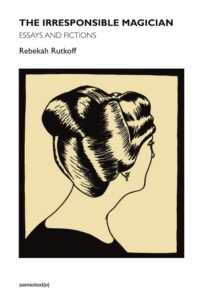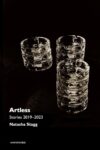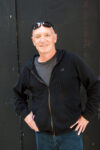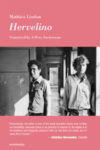
[Semioetext(e); 2015]
While reading Rebekah Rutkoff’s The Irresponsible Magician: Essays and Fictions, I kept thinking of this passage from Clarice Lispector’s Água Viva:
I’ll return to the unknown part of myself and when I am born shall speak of “he” or “she.” For now, what sustains me is the “that” that is an “it.” To create a being out of oneself is very serious. I am creating myself. And walking in complete darkness in search of ourselves is what we do. It hurts. But these are the pains of childbirth: a thing is born that is. Is itself. It is hard as a dry stone. But the core is soft and alive, perishable, perilous, it. Life of elementary matter.
The “I” is unstable, multiple, and identity is fluid in Rutkoff’s book of stories and essays, as she plays with the genres of fiction and autobiography. This is captured in “A Valentine for Mr. Wonderful,” where the narrator says that while attending a dinner for Varnedoe’s Jackson Pollock retrospective at MoMA, she “experienced the rewards of not knowing who I was in such a clean, bubble-like way. I drank so much that I insisted on taking the subway home, and woke up when the D line terminated at Brighton Beach.” Here is the freedom of movement, but not towards a specific destination; forget “yourself.” Michaux: “don’t let ‘you’ takeover, you are contagious to yourself.” In the fictionalized autobiographical works, she assumes and discards roles, and in one case, “the cutting edge of gender softens”; her fictions are performative. This is how we are in society, adopting identities, “performing” in various social situations, adopting “roles,” depending on where we are or who we are with. But there are those moments when we are simply outside of ourselves, and in these moments, magic is possible.
This exploration of identity as performance can be seen in Rutkoff’s essays, as well as in her “fictions,” such as the one she titles, “The Splatter Technique: An Interior Monologue Between the Narrator and Carolee Schneemann.” Here the “I” speaking a monologue is stretched to include both the narrator (herself) and the filmmaker (herself as) in dialogue. As such, she can engage with a subject more openly and be critical as well, without the limit imposed by the “I.” She is not either/or but both. She is assuming a role while also “being herself.” This narrative now-you-see-me-now-you-don’t is a kind of magic; the magic is located in the breaking away from the idea of a fixed identity or gender. In a culture where identity is so important, to suggest that this identity is fluid, and unstable, is to transgress against the status quo, which is interested in maintaining the duality, the either/or sensibility. This can clearly be seen in the discussions surrounding transgender people, where the Right wants to enforce the idea of a fixed gender: male or female. Creating resonances between oneself and another identity is an essential part of the magician’s work, especially during a ritual, when invoking one’s relationship to a god; there is a point where the magician assumes the characteristics of the god.
But celebrities use their fame and sense of self-worth to dominate others. They are interested in maintaining their fixed identities in the media until their names become a kind of brand. Rutkoff’s narrator is fascinated by and critical of celebrity power; about Philip Roth, who she encounters in a restaurant, surrounded by fans, she writes, “It was essentially a come-sit-on-Santa’s-lap situation, and everyone, mostly the young women, took turns.” Art historian and curator Peter Galassi, “was tall, and he had his hand on the smalls of quite a few women’s backs” Women are objectified: “I met Bill Eggleston in the back office of Southside Gallery in Oxford. He was drunk and asked me to sit on his lap and said he hated big breasts.” And about the filmmaker Haskell Wexler, she writes, “I love Medium Cool and I was surprised that Haskell had so many sports cars, but he’s gentle, and you sort of forgive his tasteless relationship to his wealth because you hope it’s just an accident.” In this digital age, image is everything. Ego-driven famous people, who feel at liberty to assert their sexual dominance, recur under Rutkoff’s narrative watch.
In her essay on Michael Auder, the experimental videomaker, Rutkoff quotes from William James’ essay “Stream of Thought,” where he indicates a breach in the continuity of consciousnesses:
The only states of consciousness that we naturally deal with are found in personal consciousnesses, minds, selves, concrete particular I’s and you’s. Each of these minds keeps its own thoughts to itself. There is no giving or bartering between them. No thought even comes into direct sight of a thought in another personal consciousness than its own. Absolute insulation, irreducible pluralism, is the law.
But these “contiguous spheres” of consciousness bleed into each other. Mind permeates matter. What appears as discrete, and as a series of stops and starts, is also continuous. Insofar as we identify and categorize, we see things as separate, but as the uncertainty principle in physics show us, we cannot know a particle’s mass if we know its speed; i.e. as we define the particle, it becomes discrete but in fact it is continuous. It is both particle and wave. One interesting case in an Auder video shows both the continuity of a conversation and the breach James was talking about; here it is caused by a mishearing; a daughter and father are talking about her boyfriend and the father is opposed to their seeing each other:
Daughter: Mama wants to know if it’s convenient for you to talk to him?
Father: Talk to her?
Daughter: Yeah. Alright ‘cause there’s something she’s gotta tell you …
Father: Is it about you?
Daughter: Yeah.
Father: What is it now?
Daughter: You’re gonna be disappointed but it’s something.
Father: Don’t tell me you saw Billy again.
The daughter uses the pronoun “him,” suggesting that the father should talk to the boyfriend. But the father hears it as “her,” indicating he should talk to his wife. This mistake shows how the continuity of a conversation is subject to a breach, an error in interpretation, as in a Freudian slip. The contact between subjective worlds is subject to error and misinterpretation and not absolute truth. Identity is not stable. Not black and white. There is no black or white magic; the magician dissolves the distinctions into gray: not either/or but both.
The essay “The Art of Transcribing a Sunset,” on Claude Levi-Strauss, is crucial to Rutkoff’s poetics. She is not interested in the construction of solid structures but fluid poetic spaces that are not closed but open; she subverts the idea of the singular authorial presence, and assumes multiple voices. In this essay, she points out that Strauss’s professional language becomes unstable and poetic in his attempt to “transcribe” the sunset he witnessed while on a boat traveling to Brazil. The wide ocean can be seen as a maternal space, a womb that gives birth to change, transforming those who travel upon her waters: “The sunset-inspired, voyage-out narratives of anthropologists deserve our attention: ship-board preludes to fieldwork tell us much about the stimulation and imagination of an anthropological mind before the purported objects of study have been reached.” Strauss is no longer acting as an anthropologist; his professional identity is no longer something he can rely on. Curiously, he believes that if he is able to accomplish this task of finding a language that can convey the sunset, which is so “unstable and so resistant to description,” he will have discovered the “deepest secrets of my profession.” It is a striking statement coming from an anthropologist.
The exact description of the sunset has not been achieved yet, therefore formalized. Once named it denotes a thing that happened, which is finite. The “sunset,” prior to being named, is infinite, an open possibility, an “effect” without a “cause.” The truth about reality is not in conventional, administrative, professional, even academic, language, but in the poetic, that which lies hidden, mysterious, infinitely open, and that emerges when the frames in which we commonly view ourselves and the world break down. The excess then floods in. And we are overwhelmed. Speak in tongues. In viewing the sunset, Strauss uses phrases like “bloated and ethereal ramparts, all glistening, like mother of pearl, with pink, mauve, and silvered gleams” or “streaks of dappled blondness decomposing into nonchalant twists.” The language has become visual and poetic. It is a kind of magic that Strauss performs, where he is no longer an anthropologist but a poet.
But then this poetic evocation alters as the night arrives. Strauss returns to his identity as an anthropologist, a professional, a structuralist, a writer, and “the turning of the sky is linked to forms of art”: “Daybreak is a prelude, the close of day an overture which occurs at the end instead of the beginning, as in old operas.” The poetic sky is subsumed under notions of art and culture, of civilization, custom, and identity. Recalling the Lispector quote, the “it” has now become a “she” or “he.” Cultured. Civilized. Either /or instead of both. Black and white without the diversity of colors.
In the essay “The Incubators,” Rutkoff writes, “I think of H.D. and [Gregory] Markopoulos as kindred protectors of the poetics of separation. They prevent overlap and merger between discrete images, and know the importance of singling out frames, symbols and colors in the process of divining, naming and reordering one’s own objects, psychic and material.” Then she quotes from H.D.’s poem “Magician”: “I say, / take colour; / break white into red, / into blue / into violet / into green; /I say, / take each separately, / the white will slay.” Here again we have the balance of the discrete and the continuous, the merging and the separation. The white contains all colors without diversity; it stands for homogenization, and is dangerous. Think of our present time, where we see the emergence of nationalism and the attacks on Black Lives Matter by white power groups. Diversity is what matters: colors and not the uniformity of white. We are singular but also plural; I but also We; all the pronouns. In alchemy, one must dissolve and coagulate (salve et coagula, which means “separate and join”), which means separate and join. For H.D., this is the work of a magician. Thus, to see the world as diverse (people as separate, different) but collective (people as the same, joined together) is a magical act.
The colors in Rutkoff’s photographs are not vibrant or loud but rather quiet and subtle; the eye focuses on the pale pink tablecloth in one photo, or a strip of rainbow on a bedspread in another, or glass tumblers where the colors are blurred. The world these photos evoke is fleeting and temporary; they are snapshots from when she was traveling, poetic visions of everyday objects, and sometimes people. They complement the fictions and essays since, in their own way, they perform a kind of magic: the transformation of objects into talismans. She is divining, and naming, those things she photographs. They are her secret hieroglyphs of a vanishing world.
Rutkoff’s book is not explicitly political; she is concerned with poetics, language, image, and by extension, celebrity. We are not bound by our identity or gender; we can play with the genre of autobiography and fiction. Robert Glück, in Communal Nude: Collected Essays (Semiotext(e), 2016) speaking of Dean Smith’s black hole sun #2 (2001), writes, “Like a Rorschach test, Smith’s drawings both suggest story and show how chance works against story’s seaming inevitability, including the inevitability of the self.” For Rutkoff, dreams are a valid form of expression, undercutting the need for linear narrative to determine every aspect of the text; the poetic language of dreams is unstable, subject to fluctuation, change; Levi-Strauss is unable to maintain this alternate space and reverts to his position as an anthropologist. His magic dissolves. Rutkoff’s book is a rejection of this return. As she shows, our identities are also subject to disorientation, from which state emerges the freedom to not have to assume the daily role that society demands. It is in this freedom that one ultimately becomes an irresponsible magician.
Peter Valente is a writer, translator and filmmaker. He is the author of eleven full length books, including a translation of Nanni Balestrini’s Blackout (Commune Editions, 2017), which received a starred review in Publisher’s Weekly. His most recent book is a co-translation of Succubations and Incubations: The Selected Letters of Antonin Artaud 1945-1947 (Infinity Land Press, 2020). Forthcoming is a book of essays, Essays on the Peripheries (Punctum Books, 2020), and his translation of Nicolas Pages by Guillaume Dustan (Semiotext(e), 2022). Twenty-four of his short films have been shown at Anthology Film Archives. He is presently working on editing a book on the filmmaker Harry Smith.
This post may contain affiliate links.







